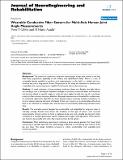Wearable Conductive Fiber Sensors for Multi-Axis Human Joint Angle Measurements
Author(s)
Gibbs, Peter T.; Asada, Harry
Download1743-0003-2-7.pdf (2.642Mb)
PUBLISHER_CC
Publisher with Creative Commons License
Creative Commons Attribution
Terms of use
Metadata
Show full item recordAbstract
Background: The practice of continuous, long-term monitoring of human joint motion is one that finds many applications, especially in the medical and rehabilitation fields. There is a lack of acceptable devices available to perform such measurements in the field in a reliable and non-intrusive way over a long period of time. The purpose of this study was therefore to develop such a wearable joint monitoring sensor capable of continuous, day-to-day monitoring. Methods: A novel technique of incorporating conductive fibers into flexible, skin-tight fabrics surrounding a joint is developed. Resistance changes across these conductive fibers are measured, and directly related to specific single or multi-axis joint angles through the use of a non-linear predictor after an initial, one-time calibration. Because these sensors are intended for multiple uses, an automated registration algorithm has been devised using a sensitivity template matched to an array of sensors spanning the joints of interest. In this way, a sensor array can be taken off and put back on an individual for multiple uses, with the sensors automatically calibrating themselves each time. Results: The wearable sensors designed are comfortable, and acceptable for long-term wear in everyday settings. Results have shown the feasibility of this type of sensor, with accurate measurements of joint motion for both a single-axis knee joint and a double axis hip joint when compared to a standard goniometer used to measure joint angles. Self-registration of the sensors was found to be possible with only a few simple motions by the patient. Conclusion: After preliminary experiments involving a pants sensing garment for lower body monitoring, it has been seen that this methodology is effective for monitoring joint motion of the hip and knee. This design therefore produces a robust, comfortable, truly wearable joint monitoring device.
Date issued
2005-03Department
Massachusetts Institute of Technology. Department of Mechanical EngineeringJournal
Journal of NeuroEngineering and Rehabilitation
Publisher
BioMed Central Ltd
Citation
Journal of NeuroEngineering and Rehabilitation. 2005 Mar 02;2(1):7
Version: Final published version
ISSN
1743-0003